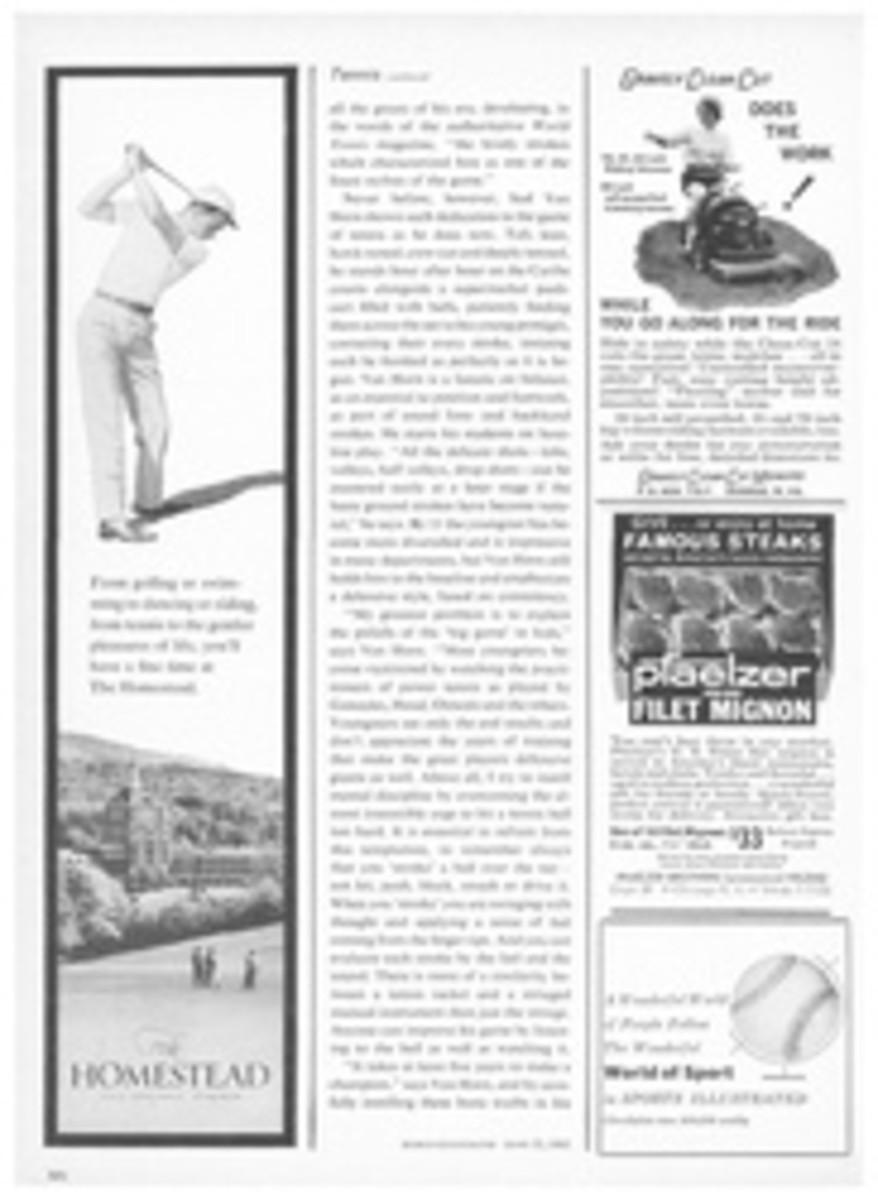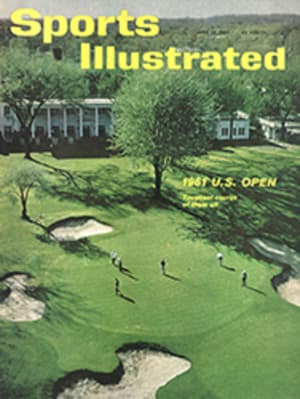
The odds go down on Cincy
When the experts at Reno's elite Turf Club got around to evaluating the chances of the Cincinnati Reds in the National League pennant race early this spring, they decided that the Reds were 25-1. The Phillies, as a point of comparison, were rated just behind the Reds at 50-1, and the Chicago Cubs were figured as 100-1. Last week the Turf Club had some second thoughts: they reduced the odds on the Reds to 5-1.
There are a number of cogent reasons for this drastic re-evaluation: a course in how to shoot BB guns, a conditioning program conducted by the operator of a leased game preserve, a dozen trades and the fruit of the intelligent, careful scouting system developed by former General Manager Gabe Paul. All of these things combined in the last fortnight to produce two winning streaks (nine and six games) by the Reds. As a consequence, the Cincinnati team, a consensus choice for sixth after spring training, rested precariously and briefly in first place last week.
Oddly enough the Reds were in first on the strength of their pitching; they had been diagnosed as a team with more than enough power, much less than enough pitching. But one big, wild youngster up from the farm system via Visalia and Columbia changed that. His name is Ken Hunt, and he owns a fast ball which, in baseball phraseology, hums. For a long time it hummed somewhere outside the strike zone; this year it has been accurate as well as fast.
"We signed Hunt four years ago," says Phil Seghi, head of the Red farm system. "He was signed by one of Gabe Paul's scouts [a peculiarly sentient group who are responsible for seven of the players on the present Cincinnati club—Pitchers Hunt, Jay Hook, Jim Maloney and Jim O'Toole and Vada Pinson, Elio Chacon and Frank Robinson]. We sent him down to Dave Bristol at Visalia his first year. We knew he was wild, and we told Bristol to pitch him every four days, regardless. Dave called in after a few weeks and said, 'Do I really have to pitch this guy that often? They're gonna run me out of town.' We told Dave he had a job even if they did run him out of town; keep using Hunt. The only way a pitcher gets control is through work."
That first year, Hunt pitched 54 innings and walked 75 batters. The next year, with Visalia again, he worked 150 innings and walked 185 batters. Then the work began to pay off. At Columbia, in the Sally League last year, he pitched 211 innings, walked only 134 batters and won 16 games while losing but six. Still, he was so lightly regarded when the Reds opened spring training that he was not included in the publicity release from Manager Fred Hutchinson in which the Red manager talked about rookies to look for in the Red camp.
Hunt changed that quickly; the long summers spent throwing into the grandstand and into the dirt had finally taught him control. He no longer threw high and wild. The burning fast ball clipped across the plate just over the batters' knees, and Hunt was—and is—a major league pitcher.
In that spring training camp two more things contributed to the success of the Reds, although most people did not notice. Otis Douglas, a Ph.D. from the College of William and Mary who has a 3,300-acre pheasant preserve in Virginia, showed up as Physical Conditioning Consultant. He put the Reds through a sprightly course of calisthenics designed to stretch shoulder-girdle muscles, loosen hamstrings and strengthen ankle and knee joints. The Reds, a bit wary of all this exercise, finally were won over by the diffident but appealing personality of Mr.—or Dr.—Douglas and went into the regular season as well-conditioned a baseball team as there was in either league. One result of this strenuous program is the fact that Cincinnati has managed to get through the first 50-odd games of the season with very few injuries and no lost time because of pulled muscles. By contrast, the Los Angeles Dodgers have had 12 top players out for varying periods with a variety of injuries, including muscle damage.
Rehabilitating a pitcher
As a concrete example of Douglas' value to the team, there is Marshall Bridges, purchased from St. Louis in August 1960. Bridges is, when healthy, a fine relief pitcher. But he has been troubled with sore heels most of his major league career. Douglas' corrective exercises cured his sore heels, and so far this year for the Reds he has appeared in seven games with no difficulty, saving one and losing one.
Then, too, at that training camp in Tampa, a team of freehand shooting experts tuned up the Cincinnati batting eyes by teaching them to hit an aspirin tablet with a BB gun. The other day in Cincinnati a group of Reds took a refresher course in shooting. They gathered in the right-field corner at Crosley Field and, armed with air rifles, pinked away industriously at a variety of thrown targets, ranging in size from inch-and-a-half washers to BBs. Some of them, surprisingly, managed to hit the BBs. Gene Freese, the power-hitting third baseman, destroyed an Alka-Seltzer tablet with a well-aimed shot and hollered, "That's just where I hit the home run last night. On the top edge."
The shooting experts—John Hughes and Mike Jennings of Unlimited Enterprises in Columbus, Ga., both trained by Lucky McDaniel (SI, Oct. 20, 1958)—had been called in by General Manager Bill DeWitt to cure a Red batting slump. They were reasonably successful—after the unorthodox warmup with BB guns the Reds scored seven runs on the Chicago Cubs. Unfortunately, the Cubs, without benefit of BB guns, scored 10 on the Reds to knock them out of first place that day.
"Sure, the guns help," said Pitcher Jim Brosnan. "They teach you to concentrate on a target. A pitcher, when he looks at the plate, tends to pick up the biggest thing there in his line of sight. That's the batter. This kind of shooting teaches you to ignore the biggest thing in your line of sight—the gun—and concentrate on a small target. I went in against Los Angeles the other night to pitch with the bases loaded and nobody out. 1 felt tight, because I had pitched four and a half innings the day before. I knew every pitch had to be right where I wanted it. But I had learned to concentrate on a small target. I threw the ball five times, and every pitch was right on target and I got the side out."
But the conditioning—which is still going on in a small, well-equipped gymnasium just off the Red training room in the clubhouse and the target shooting are only some of the items in the Red success. Three big differences between the 1961 and the 1960 Reds are Hunt, Freese and Don Blasingame, a fiery second baseman acquired early this year from the Giants after the Reds had struggled through an eight-game losing streak in the last two weeks of April.
"We needed some one to pull the infield together," says Manager Fred Hutchinson. "Blasingame filled the bill, so we traded Ed Bailey for him and Bob Schmidt." The trade was made on April 27, and three days later the Reds started a nine-game winning streak that carried them from last place to the upper reaches of the first division.
Trades actually have been a major factor in the making of this team. Under Gabe Paul, the Reds acquired Pitchers Bob Purkey, Bill Henry and Jim Brosnan, Shortstop Eddie Kasko, First Baseman Gordy Coleman and heavy-hitting Outfielders Wally Post and Gus Bell.
The recent trades, undoubtedly engineered by glowering Fred Hutchinson, include Gene Freese at third, Blasingame at second and Joey Jay, who has been, with Hunt, the mainstay of the pitching staff. These were made after the appointment of Bill DeWitt as general manager, but they bear the stamp of Hutchinson's knowledgeability.
Blasingame has certainly tied the previously disorganized Red inner defense together; Freese, a power hitter, has added a long ball (five home runs in six games last week) and an unerring glove to the Red cause. Jay, an in-and-out pitcher for Milwaukee, has responded to the careful, kind administration of Hutchinson by winning six games so far; he appears capable of winning 20.
The catalyst for this potpourri of baseball talent is, indeed, Hutchinson. He has a dark, forbidding face, which appears angry most of the time when he sits in the dugout, staring out disconsolately at the field. He has a hot, quick temper that flares and dies like a Roman candle. But he has, too, a deep empathy with baseball players that allows him to wheedle the last ounce of effort from them.
"He picks us up," one player said last week. "He knows us. One guy may be off and he knows why, and he works on him and on another guy, too. So the other guy gets up. An up guy picks up the team. Someone has been picking up this team all year."
PHOTO
BEFORE GAME WITH CUBS, RELAXED REDS DRAW POOL SLIPS ON THE BELMONT STAKES
PHOTO
ARCHITECT OF VICTORY, FRED HUTCHINSON GLOWERS FROM DUGOUT AS REDS LOSE

